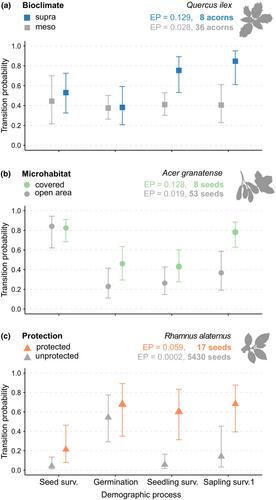EstablishMed, a dataset of transition probabilities for woody plant establishment in the Mediterranean Region
Abstract
Motivation
Plant establishment is the result of sequential demographic processes, namely post-dispersal seed survival, seed germination, seedling survival and sapling survival. These processes can be quantified as transition probabilities between life stages through field experiments, and their product provides an overall establishment probability. This information is essential to understand demography within populations and plant colonization potential under global change scenarios. The Mediterranean Region constitutes a biodiversity hotspot characterised by severe summer droughts, which suppose a critical demographic bottleneck for perennial plant establishment. Despite many studies have quantified transition probabilities of woody species in this region, information is scattered through the literature and has not yet been compiled. To fill this gap, we collated data from a systematic literature review and completed them with new unpublished data to create the EstablishMed dataset.
Main types of variables contained
EstablishMed is a compilation of 4728 records of transition probabilities that quantify demographic processes operating during plant establishment. All records belong to native species and were obtained in situ under field conditions. Each record includes information about the specific spatiotemporal context of the study (i.e., year, site, population, habitat and microhabitat) and the experimental procedures employed (e.g., degree of protection against natural enemies). In addition, we included taxonomic and trait information of the study species (i.e., seed mass, dispersal syndrome and life form), and the bioclimate of the study sites.
Spatial location and grain
The dataset covers the whole Mediterranean Region. The finest spatial resolution corresponds to microhabitat types within populations.
Time period and grain
Data were extracted from 271 studies originated between 1991 and 2024.
Major taxa and level of measurement
134 woody species from 80 genera and 39 families.
Software format
EstablishMed is available in .csv format in Dryad repository.


 求助内容:
求助内容: 应助结果提醒方式:
应助结果提醒方式:


